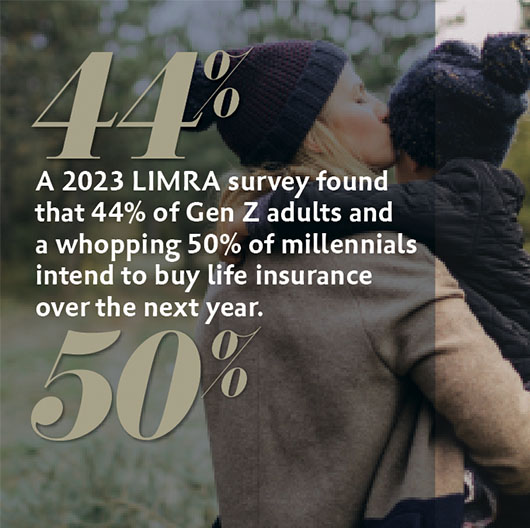Three reasons more young people
are buying long-term care and life insurance
By Adam Bezman, CLTC
Would it surprise you to hear that people in their 20s and 30s represent almost half of the purchases we see for Trustmark Voluntary Benefits’ life and long-term care (LTC) insurance? When you consider that hybrid life and long-term care products let people get two benefits in one, it starts to make sense.
A 2023 LIMRA survey found that 44% of Gen Z adults and a whopping 50% of millennials intend to buy life insurance over the next year. So, what is happening here? Why are all these young people suddenly more worried about their long-term health prospects? Three reasons for this include:
- COVID. The pandemic had a profound effect on many of us, especially when it came to our health and views on mortality. One of the barriers to the purchase of life insurance is that some people believe that dying prematurely won’t happen to them. Unfortunately, one of the impacts of COVID was that people saw it could happen to them and it brought about a different perspective on insurance.
- More exposure to family members receiving care. Many young people have been exposed to a family member who has required care and they’ve seen the impact of that care on the rest of their family. When a grandparent or other relative needs care, they are getting a first-hand look at what that means for their parents. Either their parents are providing some of the care for their family members (maybe their grandparents are now living with their parents) or they are participating in organizing the care. Either way, the children see the emotional, physical and mental toll of care on their parents.
When you consider this, it might come as less of a surprise that younger generations are taking an interest in protecting themselves against the costs of care. A 2021 LIMRA Insurance Barometer Report says millennials are more concerned about care expenses than any other generation. And millennials rank care and life insurance among the top areas they’d like to discuss with an advisor.




[M]illennials rank care and life insurance among the top areas they’d like to discuss with an advisor.

While paying for a long-term care policy that they don’t expect to use for decades may sound odd at first, when you combine the benefit with life insurance—something they do need now—it starts to make sense. The motivations behind purchasing life insurance and LTC insurance are very similar; they are both about protecting those whom you love. And being young has its advantages; young customers can minimize costs and/or get maximum coverage for what they spend, making hybrid insurance a practical way to efficiently kill two birds with one stone.
- Increased media coverage. Long-term care has become a topic that is widely covered in the media for a couple of key reasons. One is that we have an aging population. According to the U.S. Census Bureau, by 2035 the United States is going to have more people over the age of 65 than under the age of 18 for the first time in our history. People are living longer than they used to, which is driving a greater need for care in later years.
Second, this need for care has been driving states to look at legislative solutions—and the media have covered this issue in-depth, as well. The state of Washington was the first to implement a program when they passed Washington Cares, a state-run program that can provide up to $100 per day for the period of a year to help pay for long-term care. Since Washington passed its program, other states have been looking at this as well.
Advice for brokers
What should brokers be doing to address this increased need?
For starters, talk to your clients. Young people are clearly interested in long-term care and life insurance, but many have limited knowledge. Consider a range of long-term care insurance options and what may be best to offer your clients. Stand-alone long-term care insurance is available, but the truth is the stand-alone long-term care insurance market has changed a lot over the last 20 years. It’s worth looking at offering options through the workplace but, increasingly, employers are turning to hybrid life and care options.
These options offer meaningful advantages such as guaranteed issue underwriting and the knowledge that employees will be able to collect a benefit one way or another. That said, there’s a variety of products on the market each with strengths and weaknesses, so rely on your carrier partners to help find the right product for your group.
What was once something that people only in their 50s and 60s started to think about, long-term care and life insurance is starting to become a very real option for employees in their 20s and 30s. Meet this interest head on. Start talking to your clients and their younger employees about long-term care and life insurance. They’ll thank you later.
The author
Adam Bezman is the executive director of product and innovation at Trustmark and is a Certified in Long-Term Care® designee.






